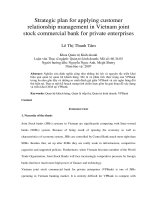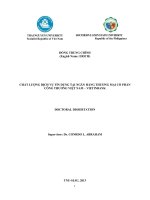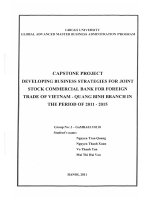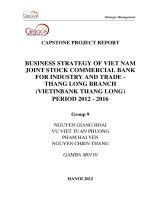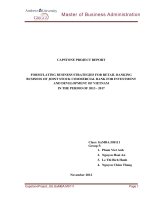Poor customer service behavior of employees at joint stock commercial bank for foreign trade of vietnam – ho chi minh city branch
Bạn đang xem bản rút gọn của tài liệu. Xem và tải ngay bản đầy đủ của tài liệu tại đây (1.19 MB, 55 trang )
UNIVERSITY OF ECONOMICS HO CHI MINH CITY
International School of Business
------------------------------
Cao Huu Thuy Linh
POOR CUSTOMER SERVICE BEHAVIOR
OF EMPLOYEES AT JOINT STOCK
COMMERCIAL BANK FOR FOREIGN TRADE OF
VIETNAM – HO CHI MINH CITY BRANCH
MASTER OF BUSINESS ADMINISTRATION
Ho Chi Minh City – Year 2018
UNIVERSITY OF ECONOMICS HO CHI MINH CITY
International School of Business
------------------------------
Cao Huu Thuy Linh
POOR CUSTOMER SERVICE BEHAVIOR
OF EMPLOYEES AT JOINT STOCK
COMMERCIAL BANK FOR FOREIGN TRADE OF
VIETNAM – HO CHI MINH CITY BRANCH
MASTER OF BUSINESS ADMINISTRATION
SUPERVISOR: DR. TRAN PHUONG THAO
Ho Chi Minh City – Year 2018
TABLE OF CONTENTS
EXECUTIVE SUMMARY ........................................................................................................ 1
CHAPTER 1: PROBLEM IDENTIFICATION ......................................................................... 2
1.1.
Company Overview ..................................................................................................... 2
1.2.
Background of the problem ......................................................................................... 2
1.2.1.
Individual customers’ complaints about VCB customer service at the counters . 3
1.2.2. Evaluation of Vietcombank’s customer service quality compared to its
competitors in the banking industry ................................................................................... 5
1.3.
Problem analysis .......................................................................................................... 7
1.3.1.
Low quality of service space and facility ............................................................. 9
1.3.2.
Low interaction quality....................................................................................... 10
1.3.3.
Lack of reliability ............................................................................................... 11
1.4.
Problem justification .................................................................................................. 13
1.4.1.
Possible problems ............................................................................................... 13
1.4.2.
Main problem ..................................................................................................... 18
1.5.
Cause validation ......................................................................................................... 19
1.5.1.
Training .............................................................................................................. 19
1.5.2.
Motivation .......................................................................................................... 21
1.5.3.
Design of customer service job .......................................................................... 21
CHAPTER 2: SOLUTION ....................................................................................................... 23
2.1. Alternative solutions ...................................................................................................... 23
2.1.1.
Contents of training ............................................................................................ 23
2.1.2.
Methods of training ............................................................................................ 24
2.1.3.
Training sources: ................................................................................................ 25
2.2.
Selected solution for Vietcombank HCMC branch ................................................... 27
2.3.
Action plan ................................................................................................................. 29
2.4.
Conclusion ................................................................................................................. 31
CHAPTER 3: SUPPORTING INFORMATION ..................................................................... 33
3.1. Summary of methodology ......................................................................................... 33
3.2.
Information of in-depth interviews conducted ........................................................... 33
3.2.1. In-depth Interview - Section 1 ................................................................................ 33
3.2.2.
In-depth Interview - Section 2 ............................................................................ 39
3.2.3.
In-depth Interview - Section 3 ............................................................................ 46
3.3.
REFERENCES .......................................................................................................... 48
LIST OF FIGURES
Figure 1: Organization’s structure of Vietcombank Ho Chi Minh City Branch
Figure 2: Evaluation of customer service at transaction counters of six commercial
banks
Figure 3: Customers’ evaluation scores for service provider and service environment
of six commercial banks
Figure 4: Initial cause-effect map
Figure 5: Final cause-effect map
Figure 6: Updated cause-effect map (alternative solutions added)
LIST OF TABLES
Table 1: Popular problems customers complain about Vietcombank HCMC branch
Table 2: Result of evaluating quality of service provided by Vietcombank’s tellers
Table 3: Demographic of customers chosen for interview
Table 4: Demographic of staffs chosen for interview
Table 5: Estimated cost for training program
Table 6: Action plan
EXECUTIVE SUMMARY
The banking industry in Vietnam is becoming more comparative in recent years. Big
state-owned banks such as Vietcombank, BIDV and Vietinbanks now have to compete
with various private banks which are rising quickly. All the banks attempt to retain
loyal customers and increase their market share, so they have to pay attention on
improving the quality of customer service. It is not a stretch to say that customer
retention in the banking sector depends primarily on customer service. Today’s
customers are more knowledgeable of their options. So once they have chosen a bank,
they expect a high level of customer service. The importance of customer retention in
banks depends on these institutions stepping up to the plate and delivering on the
quality of service that is expected.
The purpose of this thesis is to explore the causes of poor customer service behavior
problem at Joint Stock Commercial bank for Foreign Trade of Vietnam - Ho Chi Minh
City branch (Vietcombank HCMC branch). This problem is viewed through the
symptom of low customer’s satisfaction about service quality at Vietcombank
counters.
The findings of the study reveals that the main cause of this problem is the lack of a
formal training program on customer service for all employees working at this field of
the bank. The findings are discussed in details in the research along with some
recommendations for the company and management board to increase the level of
individual customer service quality in order to improve customer satisfaction of
Vietcombank HCMC branch.
Page | 1
CHAPTER 1: PROBLEM IDENTIFICATION
1.1. Company Overview
Joint Stock Commercial Bank for Foreign Trade of Vietnam (Vietcombank) was
established on 01/04/1963 from the Foreign Exchange Bureau (of the State Bank of
Vietnam). From 02/06/2008, Vietcombank successfully implemented the equitization
plan through IPO.
During more than 50 years of growth and development, Vietcombank has contributed
significantly to the stability and growth of national economy, upholding the role of a
major foreign trade bank in facilitating efficient domestic economic growth as well as
influencing considerably on regional and global financial community.
Originated founded as a specialized bank for foreign trade, Vietcombank nowadays
has become a versatile bank that provides customers with a wide range of leading
financial services in international trade, including traditional services such as capital
trading, capital mobilization, credit, project financing…etc., and modern banking
segment such as forex trading and derivatives, card services, e-banking and so on.
Vietcomabank Ho Chi Minh City Branch (VCB HCM) was established in 1976. After
more than 40 years of growth and development, VCB HCM has now become the
largest branch in VCB system which contributes more than 30% of total profit before
tax of Vietcombank in recent years. Total asset of VCB HCM at 31/12/2016 was
102.808 billion VND, total deposit was 99.851 billion VND and total loan was 76.258
billion VND.
Board of
Directors
Accounting
department
Trade
offices
Service
departments
Individials
service
department
Credit
departments
Corporate
service
department
Individuals
Technical
department
Human
resources
Corporate
Figure 1: Organization’s structure of Vietcombank Ho Chi Minh City Branch
(Source: Human Resources Department of Vietcombank HCMC Branch)
1.2.
Background of the problem
Page | 2
This part discusses the problem of low evaluation of individual customer service
quality at Vietcombank’s service department.
Service department (or front office) of Vietcombank includes customer service
departments and trade offices that serve customers directly at counter with most of the
basic services of the banks, such as depositing, withdrawing or transfering money, etc.
Vietcombank HCMC branch has eleven trade offices and two customer service
departments which are front offices and serve both individual and organizational
customers directly through transaction counters. Tellers working at these trade offices
are the face of the bank, thus they should be prepared with high skills of customer
service. Service quality for individual and organizational customers are both
important, but individual customer service is more essential to the bank since
Vietcombank wants to develop its market share in retail banking sector with the target
to become “The Vietnamese number-one bank in retail banking sector”. Besides that,
number of individual customers are much higher than organizational customers for a
bank. Therefore, a report by VCB showing increasing number of complaints of
individual customers in recent time (discussed in part 1.2.1) is a threat for this bank’s
development. Thus, this thesis wil focus on analyzing service quality for individual
customers only, instead of both individual and organizational customers, through two
main symtoms mentioned in this part as following: Increasing customer complaints
and low customer evaluation compaired to competitors.
1.2.1. Individual customers’ complaints about VCB customer service at the
counters
In recent years, Vietcombank has focused on developing its market share in retail
banking sector with the target to become “The Vietnamese first ranked bank in retail
banking sector”. However, Vietcombank often receives complaints about customer
service quality by individual customers who have experienced customer service at the
bank’s transaction counters. Being the largest branch of Vietcombank, HCMC branch
is also the branch that receives most complaints from customers.
According to figures provided by Vietcombank’s Retail Banking Product Management
Department in monthly Customer Service Report, which is sent to all employees by
email, number of complaints about customer service quality at Vietcombank hotline
Page | 3
has always accounted for more than 60% in recent months in 2017, in which HCMC
branch often accounts for the highest percentage (about 20%) since its scale is much
larger than others. The below table shows the sectors of complaints and popular
problems customers are not satisfied with after they experienced service at
Vietcombank HCMC branch’s counters.
Table 1: Popular problems customers complain about
Vietcombank HCMC branch
Sector of complaints
Customer service at
VCB transaction
counters (61%)
Popular problems
- Tellers take long time to get the transaction done
- Tellers make errors during making the transactions
- Low consulting quality
- Tellers show bad attitude towards customers
- Card has not been activated
- Customers' information has not been updated
- Debit/Credit card is stuck in the ATM
(Source: Vietcombank’s Retail Banking Product Management Department)
Product problems (card,
ATM,...) (39%)
It can be seen from the table that 61% of the complaints for service at Vietcombank
HCMC branch is about customer service, including bad service and attitude of
employees.
Not only receiving lots of complaints at hotline number, it is also recorded that
Vietcombank are often complained about bad customer service by individual
customers on social media. Through a survey done in 2016 by BuzzMetrics - a local
research company in Vietnam, Vietcombank is one of the local commercial banks that
received most complaints about customer service quality through discussions and
comments of customers on social networking sites like Facebook and forums, stated
by Kim1. Service quality of Vietcombank and other state-owned banks are always
evaluated to be not as good as services at private banks such as Techcombank,
Sacombank, ACB and so on. Especially, bad staffs’ attitude towards customers is the
most serious problem of Vietcombank’s service quality when it accounts for 21% of
comments on social media1.
Page | 4
1.2.2. Evaluation of Vietcombank’s customer service quality compared to its
competitors in the banking industry
Planning to enlarge the market share of individual customers, Vietcombank defines
that customer service is one of the key factors that attract individual customers and
keep them stay with the bank as royal customers. Acknowledging that individual
customers are not satisfied with service they provide, Vietcombank HCMC branch has
investigated this weakness by comparing customer service quality evaluated by
individual customers between Vietcombank and five other popular commercial banks
including Vietinbank, BIDV, Sacombank, Techcombank and ACB. This program was
conducted in July 2017 for all 11 trade offices and Individual Customer Service
Department of Vietcombank HCMC Branches in Vietnam and a number of transaction
counters of other five banks mentioned above. A market research company was hired
by Vietcombank to send their staffs playing as secret customers. These secret
customers visited all the trade offices of Vietcombank HCMC and one trade office of
each other five banks. They played as normal customers and experienced the bank’s
customer service, and then give score to criterias which were listed in advance. The
overal evaluation score for the six banks are as follow:
98
97.4
96.7
97
96.4
96
95
93.8
94
93
92.9
92.9
92
91
90
Customer service quality evaluation
Vietcombank
Vietinbank
BIDV
Sacombank
Techcombank
ACB
Figure 2: Evaluation of customer service at transaction counters
of six commercial banks
(Source: Vietcombank’s Retail Banking Product Management Department)
Page | 5
Figure 2 illustrates result of Vietcombank’s evaluation program, which scored and
compared customer service quality at counters of six commercial banks. It is
concerning that Vietcombank has the lowest score of 92,9 over 100 points together
with Vietinbank, while the group of private banks have extremely high score,
especially Techcombank ranked first in customer service quality with 97,4 points.
The evaluation was based on two factors, which are the quality of transaction
offices and tellers/officers. While Vietcombank’s transaction offices were rated with
medium score that was in the middle range compared to other banks, Vietcombank’s
tellers were not highly evaluated since the score given was almost the lowest one
among six banks, as shown in Figure 3 below:
Vietinbank
BIDV
Sacombank
Techcombank
ACB
95.5
96.8
97.3
94.9
97
96.3
96.8
91.1
91.4
93.3
96.5
98.8
Vietcombank
SERVICE PROVIDER (TELLERS)
SERVICE ENVIRONMENT
Figure 3: Customers’ evaluation scores for service provider and
service environment of six commercial banks
(Source: Vietcombank’s Retail Banking Product Management Department)
The program evaluated customer service quality of the tellers based on five main
criterias, and the scores for each factor are as following:
Table 2: Result of evaluating quality of service provided by Vietcombank’s tellers
Criterias to evaluate tellers
Average Score
90
96
73
82
95
Customs
Focusing on working tasks
Attitude towards customers
Professional knowledge and skills
Receiving and dealing with customers’ complaint
timely and responsibly
(Source: Vietcombank’s Retail Banking Product Management Department)
Page | 6
Attitude towards customers and professional knowledge and skills are the two
factors that received the lowest scores with 73 and 82 points over 100 points
respectively. These are key factors that pulled down the overall score of
Vietcombank and made this bank being ranked lower than competitors in customer
service. This result can be considered as a reconfirmation for the problem of bad
customer service quality for individuals at Vietcombank. While Vietcombank has
strived to become one of the leading banks in retail banking section in recent years,
the fact that its service quality for individual customers is not good enough to
compare with private banks like Techcombank, Sacombank,... might be a barrier for
it to retain royal customers and develop market share over its competitors in banking
industry.
1.3. Problem analysis
Previous studies of Salim2 found that in order to determine customer’s perceptions of
the overall banking service quality, banking service product quality plays an important
role. According to Parasuraman et al3, there are ten dimensions in banking service
quality and they are access, communication, competence, courtesy, credibility,
reliability, responsiveness, security, understanding and tangibility. Access means
availability for help, ATM access, phone access, email access and account access
when abroad. Communication refers to clear answers, informing customer of
important information, availability of status of transactions. Competence means ability
to solve problems and knowledge to answer questions. Courtesy is handling
complaints in a friendly manner and consistently courteous. Credibility means
confidence in the bank’s service good reputation. Reliability refers to correct service,
keeping service promise, accurate records and keep promise as advertised.
Responsiveness refers to prompt service quickly, quick problem solving and
convenient
service.
Security
includes
the
maintenance
of
confidentiality.
Understanding the customers means personalized attention. And tangibility is the
appearance of physical facilities, equipment, personnel, printed and visual materials.
Gronroos4, on another manner, argued that perceived good service quality consists of
six criteria: professionalism and skills, attitudes and behavior, accessibility and
flexibility, reliability and trustworthiness, recovery, reputation and credibility. Among
Page | 7
these criteria, the two criteria - professionalism and skills, attitudes and behavior seems to be related to the symptoms of the non-satisfaction of customers about
Vietcombank’s customer service, which was reported by Vietcombank’s Retail
Banking Product Management Department as following:
Tellers take long time to get the transaction done
Tellers make errors during making the transactions
Low consulting quality
Tellers show bad attitude towards customers
From the alternative literatures reviewed, unprofessionalism and low skills of
Vietcombank staffs, and negative attitudes and behaviors are considered as potential
problems that lead to low individual customer service quality at Vietcombank.
In order to figure out the actual problems, we will conduct research with in-depth
interviews to validate these potential problems. The research will focus on the problem
of low individual customer service of Vietcombank HCMC branch only rather than the
whole system of Vietcombank, since it is hard to do research on the whole system of
the bank for a large bank with approximately 100 branches like Vietcombank. Besides
that, focusing on smaller scope of research would also allow us to develop more
effective solutions.
In order to identify the problem, the first section of interview was conducted for the
group of four individual customers who came to different trade offices of VCB HCMC
branches to make transactions. These customers are interviewed about their feelings
and comments for Vietcombank’s customer service quality after they visited the bank
to make transactions.
Table 3: Demographic of customers chosen for interview
No.
1
2
3
4
Name of customer Age Gender
Nguyen Hoa
25 Female
Ha Thi Thuy
37 Female
Le Van Ba
28 Male
Truong Dinh Khoi
40 Male
Name of transaction point
Individual Customer Service Dept
Individual Customer Service Dept
Le Thi Rieng Trade office
Ton Duc Thang Trade office
From the interviews conducted, there are some key reasons leading to the low
evaluation of Vietcombank’s customer service quality at transaction counters,
Page | 8
including low quality of service space and facility, low interaction quality and lack of
reliability.
1.3.1. Low quality of service space and facility
Service space and facility can be understood as the space where service providing
happens, which includes both interior and exterior of trade offices, transaction
counters and other facilities at the trade office. Through the interviews, four individual
customers revealed that there are some problems about the bank’s space and facility
that they were not satisfied with. These customers agreed that if conditions about space
and facility are improved, they would feel more comfortable and they evaluate the
bank to be more professional. The most popular problems they mentioned are as
following:
Unappealing transaction space (including both exterior and interior): trash on the
floor; sloughing wall; disorderly equipment arrangement;...
Untidy appearance of transaction counter: unorganized documents/trash on the
counter; tellers put their food, drink and things unrelated to work on the
counter;...
For more details, there is two out of four customers interviewed shared that she was
not happy with the bank because of the unattractive appearance of the transaction
space:
“I went to Le Thi Rieng trade office to get my cash deposited. Outside the front door of
the bank, there was some trash on the floor and they even put a broom and a mop on the
way in. Inside the office was also quite messy and unprofessional when they put a
folding chair behind the transaction counter, which I guess is used for lunch break.” Mr. Ba shared in the interview.
Mr. Khoi, who had made transaction at Ton Duc Thang trade office, also shared that:
“I have a little bit uncomfortable feeling about this trade office because it is quite old.
The paint on the wall is sloughing and outside the bank, the sign plate and logo of the
bank are faded. Not all trade offices of Vietcombank are like that, but I go to this office
frequently because it is located near my work place. If the bank’s facility is newer and
the space is more luxurious, I would feel that their service is more professional.”
When asking these four interviewees whether they are satisfied with other service
environment factors, Ms. Hoa shared that sometimes she was also not glad to see
Page | 9
messy table behind the counter of the staff. Some staffs also put drinks such as coffee
or milk tea on the table, which may make transaction documents get dirty if they are
careless. Both of them believe that it is necessary for the bank’s employees to show
their professional appearance because that is one of the ways to express their respect to
customers.
From the interviews with customers, we can see that each customer have different
problem to feel unsatisfied with the bank’s low quality of service space and facility,
which was described as the problem of “low condition of service environment” in the
research of Rust et al5. The study indicated that service environment have affection on
the level of customer satisfaction. When service environment is in good condition,
customers feel more comfortable and they evaluate the bank to be more professional.
1.3.2. Low interaction quality
From the interviews with customers, we observe that Vietcombank’s front-line staffs
are not highly evaluated about the quality of interaction with customers. There are
many complaints about the tellers’ negative attitude and willingness to take
responsibility. Ms. Hoa, one of the customers interviewed, shared that:
“I have used service of several local banks, and I am quite disappointed with the attitude
of Vietcombank’s staffs. In general, they complete their job, but they did not show the
high quality of service attitude. For example, there were sometimes I met impolite
officers who did not show any welcome attitude to me. She did not smile with me
during the time I sat at her counter waiting for transaction completed. Even when I came
and left, she did not say “Hello”, “Goodbye” and “Thank you”.”
Moreover, Mr. Khoi who had a bad experience with the tellers at VCB Ton Duc Thang
trade office also shared with us his story:
“When I informed the teller that I could not activate my internet banking account when
I registered for it for the first time because of the bank’s mistake of sending me the
password late, her first reaction was to blame the fault to me when saying that the bank
system always send password email immediately. She said the reason was that I logged
on the account later than 24 hours as the bank had informed in the email. I was really
angry and asked her to recheck, after that she found out that the fault is due to the bank
e-system.”
Page | 10
In addition, other interviewees agreed with the opinion that tellers at VCB office are
not as friendly as other banks, especially private banks like Techcombank and
Sacombank. Some of them also shared that sometimes they have to wait for a long
time only for a simple transaction, but the tellers did not explained to them the reason
and also did not informed them the time to wait, thus they feel that they are not fully
respected by the bank staffs.
Gronroos6 confirmed the importance of interaction in the overall quality of service.
Interaction quality can be defined as a customer’s experience as a result of the
interaction with the human element of the service organization, stated by Alexandris et
al6. Gronroos7 explained that service quality consists of two dimensions: functional
(process/interaction) and technical (outcomes) dimensions. The functional dimension
refers to customer perceptions of the interactions that take place during service
delivery, while the technical dimension is what customers receive in the service
encounter (the outcomes). From this definition, it can be understood that good
interaction (functional dimensions) between the bank staffs and customers results in
higher customer satisfaction. However, the interviews with customers show that they
are not satisfied with interaction quality of Vietcombank’s employees, which is
resulted from some symptoms as following:
Unfriendly attitude of tellers
Irresponsible feedback for customer’s complaints
Unwillingness to solve customer’s problem
After examining related literatures, it is demonstrated that all of the symptoms
mentioned above refers to the problem of poor customer service behavior (CSB) of
staffs towards customers.
1.3.3. Lack of reliability
From the interview, some customers disclosed that sometimes they felt lack of
reliability with the bank when making their transaction. Two out of four interviewed
customers shared that they have experienced this problem in detail:
“Yesterday I went to Ton Duc Thang trade office to close my bank account and
withdraw money. I received my money and thought that the transaction was smoothly
completed. However, this morning, the bank’s staff called me and informed that there
was an amount of money transferred into my account yesterday but due to mistake of
Page | 11
the bank system, that amount of money was not presented in my account at the time I
closed it, so today the bank will transfer to me that amount of money. From the
customer’s point of view, I think that kind of mistake makes me feel lack of reliability
on the precise and safety of the bank” - shared by Mr. Khoi.
Asking Ms. Le Vi - Manager of Ton Duc Thang trade office about this occasion, she
revealed that this kind of mistake already happened several times due to the procedure
of transaction system:
“In this case, the money transferred in to the customer’s account after the account is
closed. In a logical way, we think that the correct procedure is that after she closes her
account, money cannot be transferred to that account anymore. However, the fact is the
bank system only truly closes the account at the end of the day after all the transactions
are done. Therefore, there is a gap for mistake when the bank system let the customer
withdraw money and close account already but after that it still received money into that
account on the same day.” - Ms.Vi said.
Ms. Hoa, another customer, also complained about the reliability of the Vietcombank’s
banking process when she doubted that this bank has leaked his information for sales
men of real estate. She shared that:
“There was a time after I opened a credit card at Vietcombank, I received lots of calls
from sales men of real estate to offering me their apartments. I guess that my
information at Vietcombank has been leaked out and I am not happy with that.”
These information above demonstrates that to some extent, Vietcombank did not gain
customers’ total reliability, which is one of the factors affecting customer satisfaction,
as stated by Parasuraman et al8. From the interviews, factors contributing to the nonreliability of these customers include:
Employees of the bank provide error service.
Employees of the bank did not keep customer’s information confidential.
All the problems complained by customers above would be a result of inefficient
internal process, which was described by Salim2. As mentioned by Gronroos7, service
quality is split into two dimensions: technical quality and functional quality. Technical
quality is how the customer receives the outcome of the process, as defined to include
interaction quality mentioned in section 1.3.2. On the other hand, functional quality is
how the service encounter is taken care and how the service provider functions. In this
Page | 12
case of Vietcombank, the problem of inefficient internal process is referred to
functional quality.
As can be conluded from the interviews with customers, there are three possible
problems leading to the low evaluation of individual customer service quality: low
condition of service environment, poor customer service behaviors and inefficient
internal process. These potential problems are illustrated in the following is the initial
cause-effect map:
Unappealing
transaction space
Low quality
of service
space and
facility
Untidy transaction
counters
Low condition
of service
environment
Unstandardized
appearance of
employees
Decrease of
the bank’s
reputation
Unfriendly attitude
of tellers
Low customer
service quality
Loss of
current and
future
customers
Low
interaction
quality
Irresponsible
feedback for
customer's
complaints
Unwillingness to
solve customer's
problems
Staff makes errors
when providing
service
Lack of
reliability
Lack of
confidentiality in
customer's
information
Poor CSB
(customer
service
behavior)
Inefficient
internal
process
Figure 4: Initial cause-effect map
1.4. Problem justification
1.4.1. Possible problems
The purpose of this part is to justify three possible problems which are shown in the
initial cause-effect map (Figure 4), which are low condition of service environment,
poor customer service behavior and inefficient internal process.
Page | 13
These posible problems are justified through the second interview section, which was
conducted with a group of four people: a teller and three managers working at
Individual Customer Service Department, Le Thi Rieng and Ton Duc Thang trade
offices of VCB HCMC branch. These in-depth interviews were carried out after the
interviews with customers, which help confirm the problems those customers
complained in order to have a two-way approach towards the problems.
Table 4: Demographic of staffs chosen for interview
1
Ms. Vu Thi Huyen
Teller
Name of VCB
Branch
HCM City Branch
2
Ms. Vu Thi Van Ha
Manager
HCM City Branch
3
Mr. Phan Van Binh
Manager
HCM City Branch
4
Ms. Le Vi
Manager
HCM City Branch
No.
Name of staff
Position
Name of
transaction point
Individual
Customer Service
Department
Le Thi Rieng
Trade office
Ton Duc Thang
Trade office
The four interviewees were asked for their opinions about the three possible problems.
From the information collected from them (which is analyzed in detail as following), it
can be educed that the main problem of Vietcombank low individual customer service
is poor customer service behavior.
Low condition of service environment
Service environment was defined and proved to affect the quality of device delivery
and customer satisfaction through many studies in the past. According to Rust et al5,
service environment of the bank comprises of extrior and interior appearance of the
bank facility, and appearance of service provider – in this case, service providers are
the tellers of the bank. Lin et al9 devided service environment into two catergories:
physical environment and social environment. Lin’s definition give a larger meaning
for the term “service environment” while physical environment refers to ambient and
design factors and social environment refers to the displaying of employees and
customer climate6.
About the influence of service environment on quality of service outcome, Lin et al9
mentioned that:
Page | 14
“Service environment plays an important role in service delivery because environment
can foster pleasant emotion reactions, while strenthening customer perceptions and
retention”.
Ryu et al10 emphasized the influence of physical environment on customer satisfaction
that pleasing physical surroundings (e.g., lighting, decor, layout and employee
appearance) may determine to a large extent the level of customer satisfaction. The
study also explained that because services are mainly intangible and often require the
customer to be present during the process, the physical environment can have a
significant impact on perceptions of the overall quality of the service encounter, which
in turn affects customer satisfaction.
After examining some prominent problems of service environment recorded by the
customers, reconfirmation of the problems was made through the interviews with
Vietcombank’s staffs and managers. Firstly, for the occasions of unappealing
transaction space at Le Thi Rieng and Ton Duc Thang trade office, the managers of
these two trade offices, Mr. Binh and Ms. Le Vi, admitted the bad condition of facility
and appearance in the present, but it is only temporary situation and they are going to
fix it soon. Because these offices are quite old, they have planned to repaint the wall
and replace old and broken facilities in few weeks. At this time, they are preparing for
the reparation, thus there might be messy and unorganized appearance of the
transaction space sometimes. They acknowledge the downgrade of facilities for years,
but because the procedure of getting permission to fix the building took long time to
be completed. Therefore, we could not timely replace the old facilities. From the
complaints of customers, they would learn from this experience and attempt not to
make similar mistakes again.
Secondly, about the problem of untidy transaction counters, Ms. Le Vi - Manager of
Ton Duc Thang trade office shared that:
“Sometimes they place too many documents or files on their table, behind the counter, it
might because there are too much customers to serve that day and with the high work
load, they do not have enough time to organize their stuffs correctly and tidily. As a
manager, I understand and do not blame my employees for that. However, the
customers are right to feel bad about that problem, so I would remind the staffs to
attempt to be neat all the time.”
Page | 15
In general, service environment quality of Vietcombank received some complaints
from customers. However, through the alternative depth interviews with the customers
and bank’s staffs as well as managers, it is concluded that most of those problems are
temporary and they are not the most significant causes that effect customer’s
evaluation of Vietcombank service quality.
Poor customer service behavior
Customer service behavior (CSB) is a field that has been studied by many researchers
in the past and they also proved its importance in affecting the evaluation of customer
service quality of a service organization. Weiner11 quoted the definition of CSB from
the research of Ryan and Ployhart as following:
“CSB is broadly defined as any activities of employees specifically directed toward
affecting service quality (e.g., greeting or assisting customers, rectifying service
failures).”
According to Weiner11, poor CSB, also understood as negative behavior of employees,
is believed to be one of the core factors lowering customer satisfaction. As defined by
Mckinney12, the term “employee behavior” refers to the way in which employees
respond to specific circumstances or situations in the workplace. Turkay et al13 have
mentioned in their study that employees display appropriate behaviors for a service
experience leads to customer’s perceive of high service quality of an organization.
But why does CSB play an important role for customers to evaluating their satisfaction
of the bank service? Weiner11 has distinguished a service-provided organization and a
goods-provided organization by the intangibility of service as contrasted with the
tangibility of goods. And when the firm provides intangible service, customers will
rely more on the service provider’s behavior as an indicator of the quality of the
service they are receiving, as stated by Bowen14. Therefore, CSB plays an important
role in enhancing evaluation of customer service quality.
From the interviews with customers, they are not satisfied with some customer service
bihaviors of Vietcombank’s employees, which include:
Unfriendly attitude of tellers
Irresponsible feedback for customer’s complaints
Unwillingness to solve customer’s problem
Page | 16
When asking Ms. Huyen, one of the tellers interviewed, weather she or her colleagues
make one of the mistakes mentioned above and why, she admitted that sometimes she
makes mistakes like not showing happy and open-armed reception or not saying
“Hello” and “Goodbye” to customers. She was just unconsciously doing that and she
thinks customers do not really matter about these tiny mistakes. The reason is
sometimes she has to serve a large number of customers in a day, so she feels tired and
unconsciously shows unfriendly attitude towards customers.
Ms. Ha - Manager of Individual Customer Service Department of HCMC branch,
admitted the fact that tellers of Vietcombank are not as friendly and polite as tellers of
other banks. In addtition, there are several times they show unprofessional behaviors to
customers like irresponsibly feedback to customers’ complaints and unwillingness to
solve customers’ problem.
Mr. Binh - Manager at Le Thi Rieng trade office - also has opinion about this issue:
“The ratio of old employees in Vietcombank is higher than other private banks. At my
department, 18 over 50 staffs at my department are over the age of 45, which is a
relative high ratio. These old officers often show bad attitude/behaviors towards
customers more than the young generation, because they have that habit from the past
when state-owned banks dominated the market and they did not have to provide good
service to retain customers.”
All of the above interviews have illustrated that poor customer service behavior is the
main problem that causes low quality of individual customer service at Vietcombank.
It was a serious problem that the bank should investigate to find out the causes and
solutions in order to improve its service quality.
Inefficient internal process
Salim2 defines internal process as a structure, messured set of activities designed to
produce a specific output for a particular customer or market. As mentioned by
Gronroos7, service quality is split into two dimensions: technical quality and functional
quality. Technical quality is how the customer receives the outcome of the process, as
defined to include interaction quality mentioned in section 1.3.2. On the other hand,
functional quality is how the service encounter is taken care and how the service
provider functions. In this case of Vietcombank, the problem of inefficient internal
Page | 17
process is referred to functional quality, which includes the two problems that
customers blamed about VCB HCM’s service:
Staff makes errors when providing service
Lack of confidentiality for customer’s information
About the first problem, the errors customers complained were related to the function
of banking information technology of Vietcombank. When asking Ms. Ha whether
there is any reason leading to the inefficiency of the bank’s internal process, she
mentioned that it might because the technology system of Vietcombank is relatively
old. Vietcombank is one of the most long-standing bank in Vietnam, so its technology
was developed before other banks. Hence, nowadays this system is older than systems
of banks which were founded later. Vietcombank is now in the process of improving
this system, but it takes several years to complete. Therefore, it can be understood that
this type of cause is objective because the staff cannot control it, as previously
explained by Ms. Ha.
Secondly, about the confidentiality problem, during the interviews with Ms. Ha, she
assured that confidentiality of customer’s information is compulsory at Vietcombank.
This bank has launched tight rules and regulations customer’s confidentiality and
every staffs that break the rules would definitely receive punishment. The leaking out
of information that the customer complained could be a misunderstanding which is
caused by the coincidence of the situation.
From the alternative interviews and literatures, it can be concluded that inefficient
internal process is not the main problem that causes low evaluation of customers about
Vietcombank service quality.
1.4.2. Main problem
The depth interviews conducted with the bank’s employees and managers has
explained that most of those problems are temporary and they are not the most
significant problems that affect customer’s evaluation of Vietcombank service quality,
except the problem of poor customer service behavior. All the four customers
interviewed shared their experiences and they were confirmed by the bank’s managers
and employees that Vietcombank’s staffs often did not show friendly attitudes towards
customers, some of them somtimes did not give responsible feedback for customer’s
Page | 18
complaints and were not willing to solve customer’s problem. This problem has
existed for long time but the employees themselves do not acknowledge all the serious
sequences of the problem. Besides that, the managers know the problem but have not
find the solution to solve it. Therefore, it can be concluded that the main problem that
leads to low evaluation of Vietcombank’s individual customer service quality is poor
customer service behavior of Vietcombank’s staffs.
1.5. Cause validation
In Weiner’s research11 about CSB, there are three factors contributing to promotion of
positive CSB:
Training employees about service providing: Formal and informal training are
critical for service organizations. Lack of or inappropriate training can lead to
lower of positive CSB.
Motivating employees: Lack of or inappropriate application of motivational tools
such as clarifying expectations, goal-setting, providing feedback, recognizing and
rewarding positive behaviors are factors that negatively affect CSB.
Design of customer service job: Some studies indicate that job design can
facilitate CSB in the way of empowerment or knowledge enlargement.
Based on these potential causes, two in-depth interviews were conducted again with
Ms. Vu Thi Van Ha - Manager and Ms. Vu Thi Huyen - teller of Individual Customer
Service department of Vietcombank HCMC branch with the purpose of figuring out
main cause of the problem.
1.5.1. Training
Through the interview, the teller was asked for her point of view on the complaint of
customers that Vietcombank staffs were behaving unprofessionally and not showing
friendly and welcome attitude towards customers. Ms. Huyen - the interviewee - did
not acknowledge that she was lack of the spirit to show her positive and responsible
attitudes/behaviors towards the customers.
“I think that it is hard to be happy and smile all day with customers when I am stressed
with my workload. I have tried my best to fulfill customers’ requirements.” - said by
Ms. Huyen.
Page | 19
Being asked about negative and irresponsible behaviors of some tellers in accessing
and solving customers’ problem and feedback to their complaints, Ms. Huyen also
shared:
“I acknowledge that it was unprofessional attitude and behavior of staffs in banking
service when they do not stand on their customer’s point of view to access the problem
and push the fault towards customers. Sometimes several colleagues in my department
make this type of mistake but I think it is unconscious because they are not truly trained
how to react correctly to customers’ complaints.”
Further sharing of this teller reviewed that most of the behaviors they presented to
customers in their customer service job are unconscious and it is because they did not
have enough skills and knowledge about customer service behavior. Most of the time,
the way they react to problems happening with customer is based on their owned
working experiences and the culture of their working place.
For further understanding about this issue, we ask manager of this department - Ms.
Ha - for her opinions. When being asked about what the bank managers have done to
improve the attitudes and behaviors of these officers, Ms. Ha shared that:
“Vietcombank nowadays has invested more in customer service, but training for
employees about good attitude for customers is still not concerned enough by the
managers.”
For specific, she revealed that there is no official and methodical training course about
standardized customer service behavior/attitude for new tellers working in her
department. New employees learned their job only from experience of the older ones.
From the discussions, it is examined that there is a lack of formal training for
Vietcombank staff on customer service including how to meet customer expectations,
increasing assertiveness, dealing with stress and how to maintain good customer
service delivery. Weiner11 mentioned the importance of formal training programs that
they are considered more critical to the success of service organization than other
kinds of organizations and they may presents special challenges compared to entrylevel training for other jobs because the content of training is often more interpersonal
than it is technical in nature. Salim2 also proved in her study that lack of training for
employees about customer service behavior and attitude would result in lower
evaluation of customers for the bank’s service quality.
Page | 20
1.5.2. Motivation
Motivation plays an important role for promoting good customer service behavior of
employees since if an employee is not motivated and happy with their work, it would
be hard for them to always show positive attitude to customers.
When Ms. Huyen was asked whether she felt unmotivated or had other problems in
their job, she said that Vietcombank has appropriate policy to motivate their
employees. She was satisfied with the benefits and regulations of the bank, the
managers are good and take care of their employees’ work life, and they do not want
to change their job in the future. Sometimes the work load is over because they have to
serve too many customers in peak hours, but they think it is their duty and they would
try their best to finish the work. In addition, according to Ms. Ha - manager of
Individual Customer Service department, the bank has applied policy and tools to
motivate employees in providing high quality of customer service. For example,
Vietcombank has just installed the evaluation system at the bank’s transaction
counters, which allows customers to give score for the level of service they are
provided as well as showing their level of satisfaction. This evaluation score is then
used for employee appraisal and decide rewards and punishment for the employees.
However, this system is just being used from the beginning of 2018, so its
effectiveness in enhancing CSB of Vietcombank needs more time to be verified.
1.5.3. Design of customer service job
Some studies have found how characteristics of customer service job affect positive
customer service behavior of employees. Campion et al15 stated that task enlargement
appeared to have costs for customer service, based on employee self-reports; however,
knowledge enlargement (adding understanding of procedures or rules) led to better
customer service, based on employee and manager reports. Rogelberg et al16 found
that job characteristics (e.g., autonomy) accounted for a significant amount of variance
in CSB.
As reviewed by Ms. Ha, at Vietcombank HCMC branch, customer service staffs are
empowered to handle the problem of customer themselves, but they still need to ask
for guidance and permission of their managers when the problem is out of their
control. According to the study of Campion et at15, this results in better customer
Page | 21
